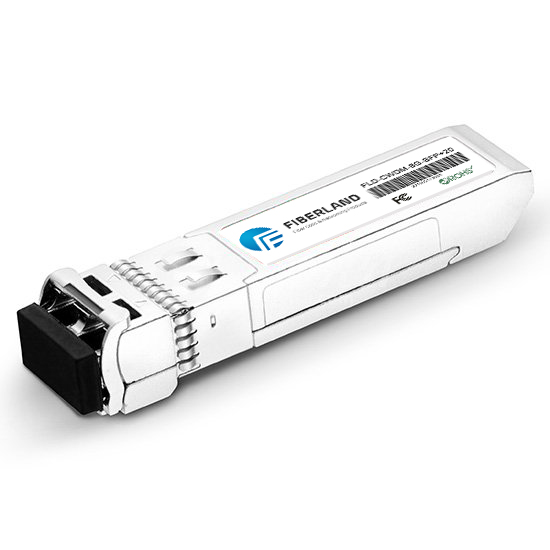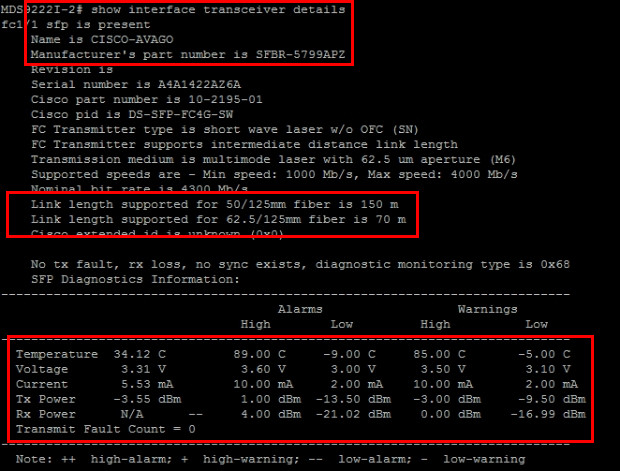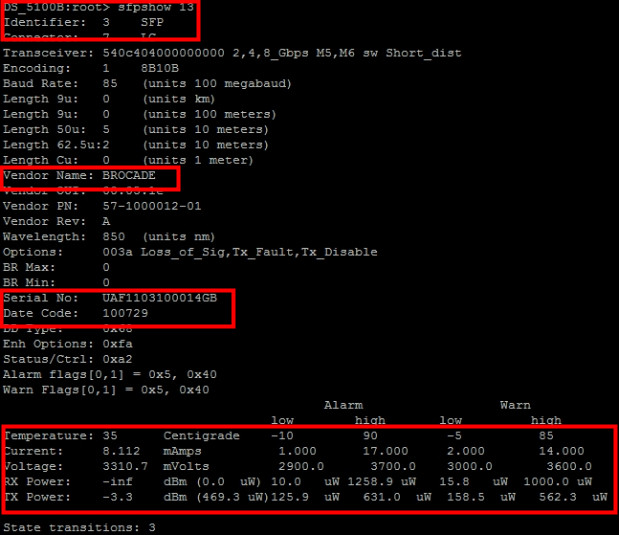How do I check the optical signal strength of an SFP optical module?
2017-09-25
As we all know, SFP optical modules support a variety of applications, such as Fiber Channel (FC) switches, SONET / SDH networks, Gigabit Ethernet, high-speed computer links, CWDM and DWDM interfaces. When the SFP+ module and the switch are connected, the optical signal strength is the key parameter to ensure the normal operation of the whole connection. This article describes the optical signal measurement method for SFP optical modules and how to view the optical signal strength of SFP optical modules.

First, the SFP optical module optical signal strength and its importance
In general, the signal strength of the SFP optical module includes both Tx power and Rx power, the former representing the transmit power signal, which represents the received power signal. For general SFP optical modules, the values of Tx and Rx power indicate that the SFP optical module is working properly within a specific plan. Taking the Cisco GLC-SX-MM optical module as an example, the transmit power is planned to be -9.5 to -3 dBm and the received power is planned to be 0 to 17 dBm. If Tx or Rx is within -30 dBm or less, it indicates that no signal has been sent or received.
The strength of the optical signal directly determines whether the network connection is normal. If the Rx power is not strong, there will be no signal in the optical link. This is why the long distance optical module or optical amplifier needs to be used for long distance transmission. If the Rx power is too large, the SFP optical module will be damaged, so choose a high-quality SFP optical module is to ensure that the network connection can be the basic guarantee of normal operation.
Second, SFP optical module optical signal strength measurement
In general, there are two commonly used methods for measuring the intensity of an optical signal: milliwatts (mW) and dBm, the former measuring the intensity of the optical signal by power, while the latter measuring the intensity of the optical signal in decibels. Different vendors may use one to measure the power of the optical signal, for example, Cisco switch selected dBm to measure, and Brocade switches used to measure with mW. Therefore, there is an equation between the two methods:
dBm->mW:mW=10dBm/10
mW->dBm:dBm=10*(Log mW)
Third, how to check the SFP optical module optical signal strength?
To determine whether the SFP optical module (transmitter and receiver) operates at the appropriate signal level, you can view the SFP optical module information, which is critical, including fiber type, transmit optical power planning, and optical reception power.
Other switches, such as Cisco and Brocade SAN switches, are available in the CLI (Command Line Interface), which is used to view detailed information about SFP optical modules, including rate, serial number, part number, and receive / send direction optical signals strength. The following picture flashes detailed information about SFP optical modules in Cisco and Brocade switches, including optical signal strength.
Cisco CLI-Display Interface Optical Module Details:

Brocade CLI-Display Interface Optical Module Details:

As can be seen from the above results, although Cisco and Brocade measure the optical signal strength of different methods, but they are supplied SFP optical module at the time of signal strength and useful optical signal strength planning. As long as the signal strength of the SFP optical module is within the useful plan, the SFP optical module can operate normally.
XFP module,XFP transceiver,bidi sfp,SFP+ module,SFP+ transceiver Which is good? First choice Fiberland!Thanks for your concern, to learn more about Fiberland, please enter Fiberland website: http://www.fiberlandtec.com/

First, the SFP optical module optical signal strength and its importance
In general, the signal strength of the SFP optical module includes both Tx power and Rx power, the former representing the transmit power signal, which represents the received power signal. For general SFP optical modules, the values of Tx and Rx power indicate that the SFP optical module is working properly within a specific plan. Taking the Cisco GLC-SX-MM optical module as an example, the transmit power is planned to be -9.5 to -3 dBm and the received power is planned to be 0 to 17 dBm. If Tx or Rx is within -30 dBm or less, it indicates that no signal has been sent or received.
The strength of the optical signal directly determines whether the network connection is normal. If the Rx power is not strong, there will be no signal in the optical link. This is why the long distance optical module or optical amplifier needs to be used for long distance transmission. If the Rx power is too large, the SFP optical module will be damaged, so choose a high-quality SFP optical module is to ensure that the network connection can be the basic guarantee of normal operation.
Second, SFP optical module optical signal strength measurement
In general, there are two commonly used methods for measuring the intensity of an optical signal: milliwatts (mW) and dBm, the former measuring the intensity of the optical signal by power, while the latter measuring the intensity of the optical signal in decibels. Different vendors may use one to measure the power of the optical signal, for example, Cisco switch selected dBm to measure, and Brocade switches used to measure with mW. Therefore, there is an equation between the two methods:
dBm->mW:mW=10dBm/10
mW->dBm:dBm=10*(Log mW)
Third, how to check the SFP optical module optical signal strength?
To determine whether the SFP optical module (transmitter and receiver) operates at the appropriate signal level, you can view the SFP optical module information, which is critical, including fiber type, transmit optical power planning, and optical reception power.
Other switches, such as Cisco and Brocade SAN switches, are available in the CLI (Command Line Interface), which is used to view detailed information about SFP optical modules, including rate, serial number, part number, and receive / send direction optical signals strength. The following picture flashes detailed information about SFP optical modules in Cisco and Brocade switches, including optical signal strength.
Cisco CLI-Display Interface Optical Module Details:

Brocade CLI-Display Interface Optical Module Details:

As can be seen from the above results, although Cisco and Brocade measure the optical signal strength of different methods, but they are supplied SFP optical module at the time of signal strength and useful optical signal strength planning. As long as the signal strength of the SFP optical module is within the useful plan, the SFP optical module can operate normally.
XFP module,XFP transceiver,bidi sfp,SFP+ module,SFP+ transceiver Which is good? First choice Fiberland!Thanks for your concern, to learn more about Fiberland, please enter Fiberland website: http://www.fiberlandtec.com/
RECENT BLOG POST
-
012019-10With the continuous development of 5G communication technology, 100G modules are gradually becoming popular. We know that there are many kinds of packages for 100G optical modules. From 2000 to now, the optical module package types have been rapidly developed. Its main package types are: GBIC, SFP, XENPAK, SNAP12, X2, XFP, SFP+, QSFP/QSFP+, CFP, CXP. In the fast-developing network era, some 100G optical modules avoid the risk of being eliminated, and upgraded and revised with the wave of the Internet, such as 100G CFP optical modules.
-
012019-101. What is the CWDM SFP? The CWDM optical module is an optical module using CWDM technology to implement the connection between the existing network device and the CWDM multiplexer/demultiplexer. When used with a CWDM multiplexer/demultiplexer, CWDM optical modules can increase network capacity by transmitting multiple data channels with separate optical wavelengths (1270 nm to 1610 nm) on the same single fiber.
-
012019-10AOC is the abbreviation of Active Optical Cables, which is called Active Optical Cables in Chinese. AOC active optical is to encapsulate two optical modules and cable together. Because the medium of transmission in the middle is optical cable, AOC optical module, which contains laser devices, has a higher price for DAC. However, its optical aperture is not exposed, it has high reliability, and its working distance can be customized for a long distance of less than 100 meters.
-
012019-10Dense Wavelength Division Multiplexing (DWDM) technology is capable of transmitting data in an optical fiber using bit wavelength parallel transmission or string line transmission using the wavelength of the laser.It is widely used in different fields of communication networks, including long-distance backbone networks, metropolitan area networks (MANs), residential access networks, and local area networks (LANs).The DWDM optical module is the optical module that uses this technology, so the DWDM optical module has high bandwidth and long-distance transmission characteristics.












